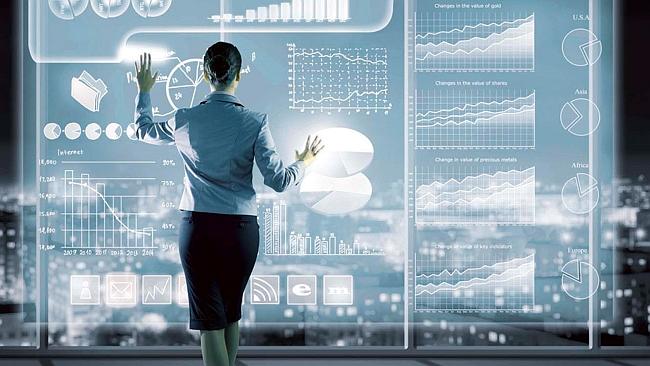First published by frank.chung@news.com.au
WHAT will the workplace look like in 2040? Imagine remote working via hologram, commuting by jetpack, even controlling your office with your mind.
MYOB has released its ‘Future of Business: Australia 2040’ report, which examines the possible impact of emerging technologies on business and work over the next 25 years.
While all manner of business interactions will continue to be “formalized, automated and digitised”, the biggest effect will be on what we currently call ‘the workplace,’ according to MYOB chief technology officer Simon Raik-Allen.
Driven by the rising cost of energy and transport, the focus of 2040 will be the ‘suburban village.’ “You will live, work, eat and learn primarily within walking distance of your house,” he writes.
Communities will pool their resources, people will trade with neighbors and list skills on local notice boards, drones will deliver packages between communities or “even a coffee and a bagel to your current location.”
Forget the traditional office or even the remote workspace — localized centers based around suburbs or communities will emerge as the home of business as a response to the growing expense of traditional inner-city office buildings, Mr Raik-Allen says.
These giant warehouses, used by employees from many different companies spread around the globe, will be home to the technology that makes the interconnected workplace possible.
“Within each will be rooms filled with giant wall-sized screens allowing us to work in a fully virtual, telepresence model. Banks of 3D printers would be continually churning out products ordered by the local community.”
Here’s a little of what could be in store:
JETPACKS
Long a dream of science fiction, personal flight via jetpacks is getting closer to reality than ever. The Martin Aircraft Company in Christchurch has developed a jetpack capable of flying for more than 30 minutes at altitudes of up to 800 feet.
“For fans of science fiction from the ‘60s and ‘70s, a number of flying cars have also been developed recently, though few have reached further than the prototype stage,” he writes.
The Martin Aircraft version is currently designed as a first-responder or unmanned transport vehicle, so those eager to go jetting around the skies like Boba Fett may have to wait a few more years.
HOLOGRAMS
Mr Raik-Allen predicts that holographic projection technology will bring about the biggest change to the workplace since email. The seminars that became webinars in the ‘90s and noughties will soon become ‘holonars.’
“You will sit in virtual auditoriums, next to three-dimensional light-based images of your colleagues from around the globe watching a hologram on the stage of someone giving a talk. And you will do this just as easily as you gather in the office today.”
Launching a new business and hiring 500 people could be done in minutes, he argues. “Your company could be just you and a couple of project managers: the thinkers, controlling every aspect of the company through new digital interfaces.”
NEW MONEY
By 2040, we’ll also start to see the emergence of a broader, stronger set of internet-based currencies like today’s Bitcoin, governed by independent bodies that manage an international network of exchanges, he writes.
They will emerge as a way for businesses to work within their closed networks, with major corporations able to create and manage their own money, make internal payments such as payroll, and even trade with other companies.
“Any business will be able to make its own cryptographic currency — to buy and sell at values regulated by the market and at the perceived value of the company. As this trend develops, exchanges of currencies, much like we have today, will arise entirely independent of national economics.”
MIND CONTROL
Here’s where it gets really crazy. If you thought smartphones and wearables were the height of personal technology, wait until you have chips implanted under your skin and downloadable apps for your brain.
Nanobots will swim through your blood, diagnosing illness and clearing blood clots. Brain augmentations will heighten our senses or allow us to control technology with our minds.
For example, implants in the retina could farm off the raw data to miniature processors implanted in our bodies, analyzing the images to identify things that can’t be seen with the naked eye, and then feed that back ‘into the stream’, effectively giving us augmented vision.
“Imagine how that would add to virtual reality,” Mr Raik-Allen says. “100 million nodes [in the retina] is not that many. In 25 years, the processing power of a single phone will probably be condensed to the size of a single red blood cell.”
Already there are examples of rudimentary ‘bio-hacking’, both of the brain and body. One experiment allowed a man to wiggle a rat’s tail with his mind; another demonstrated brain-to-brain communication, allowing two subjects to control each other’s movements.
“These things are already being done invasively, with epilepsy patients for example. We’re just beginning to understand how to process brain information and feed it back in. Eventually you will have an app store for the brain where you can download plugins — maybe to monitor various organs, or sense infra-red.”
What about mind control in the other direction? Will employers be able to bend recalcitrant employees to their will?
“If you want to be sinister about it, that will certainly be possible,” he says.
“We could work out which brain pattern is associated with looking at Facebook, for example, and which is looking at a spreadsheet. The boss could have a dashboard to see who’s working and who’s not.”



